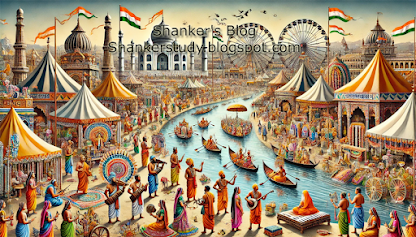
devotion meets tradition by the sacred River Ganges.
The Kumbh Mela is not just a religious gathering; it is a cultural spectacle that transcends geographical boundaries and unites humanity through shared traditions and values. From its vibrant processions to its timeless storytelling, the Mela serves as a platform for cultural exchange, artistic expression, and the preservation of India’s diverse heritage. Let us explore how the Kumbh Mela reflects the cultural richness of India.
A Hub of Cultural Exchange
The Kumbh Mela provides a stage for diverse cultural expressions, bringing together people from all walks of life:
- Folk Traditions: From traditional music to local dance forms, the Mela celebrates India’s regional cultures. Folk artists and performers share their heritage, creating a vibrant and inclusive atmosphere.
- Handicrafts and Art: Artisans from across the country showcase their crafts, from intricate handloom textiles to beautiful pottery. The Mela becomes a marketplace for traditional art forms that have been passed down through generations.
- Storytelling and Folklore: Through oral narratives, saints, and local storytellers recount ancient legends and spiritual tales, preserving India’s rich oral traditions.
The Role of Music and Dance
Music and dance are integral to the Kumbh Mela, adding rhythm and vibrancy to the spiritual environment:
- Bhajans and Kirtans: Devotional songs resonate through the festival, creating a serene yet energetic spiritual ambiance.
- Local Dance Performances: Performances like Kathak, Garba, and regional folk dances reflect the cultural diversity of India and captivate audiences.
- Naga Processions: The grand processions of Nagas and Akharas are often accompanied by drumming, chanting, and synchronized movements, symbolizing unity and devotion.
Culinary Delights of Kumbh
Food is another aspect of the cultural experience at Kumbh Mela. The festival offers a unique culinary journey:
- Regional Cuisines: Pilgrims and visitors enjoy traditional dishes from various Indian states, prepared by local vendors.
- Community Kitchens (Langars): Free meals are served to thousands of attendees, emphasizing the spirit of service and inclusivity.
Kumbh as a Cultural Preserver
The Mela acts as a living repository of India’s traditions:
- Revival of Art Forms: By providing a platform for lesser-known artists and craftspeople, the Kumbh helps revive fading traditions.
- Cross-Cultural Bonds: Attendees from different regions and backgrounds interact, fostering unity and mutual respect.
- Educational Impact: Schools and institutions often organize visits to the Kumbh to expose students to its cultural and spiritual significance.
Dr. A. Shanker
Mobile: 9818733000
www.ShankerStudy.com – ‘Bridging Ancient Wisdom with Modern Astrology’
www.ShankerAdawal.com – ‘Profile of Success: Vedic Wisdom and Business Strategy’
www.AskShanker.Com – ‘Discover the truth – ask one burning question based on your Horoscope!’
www.shrikrishnapravahashram.org – Serving Souls & Healing with Compassion: Empowering Girls, Upholding Tradition, and Offering Food to Every Guest – ‘Atithi Devo Bhava’!

